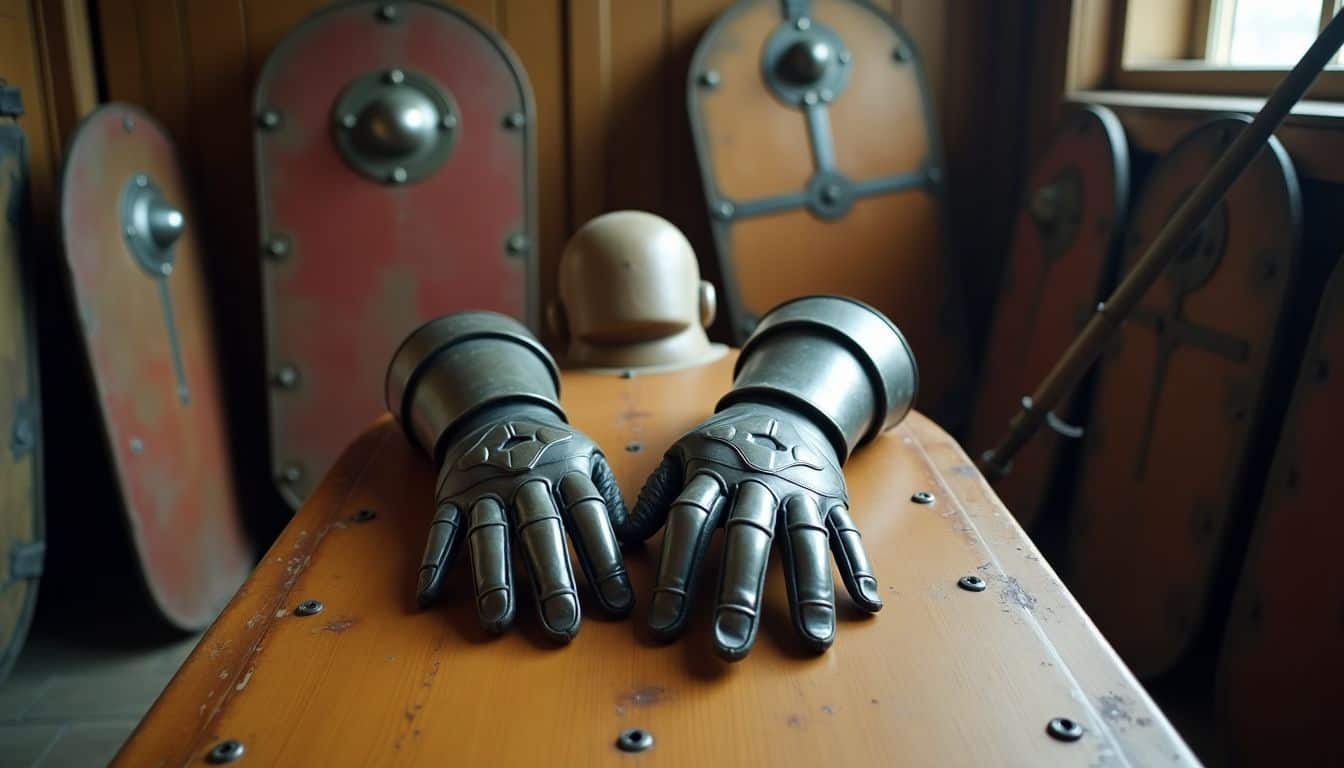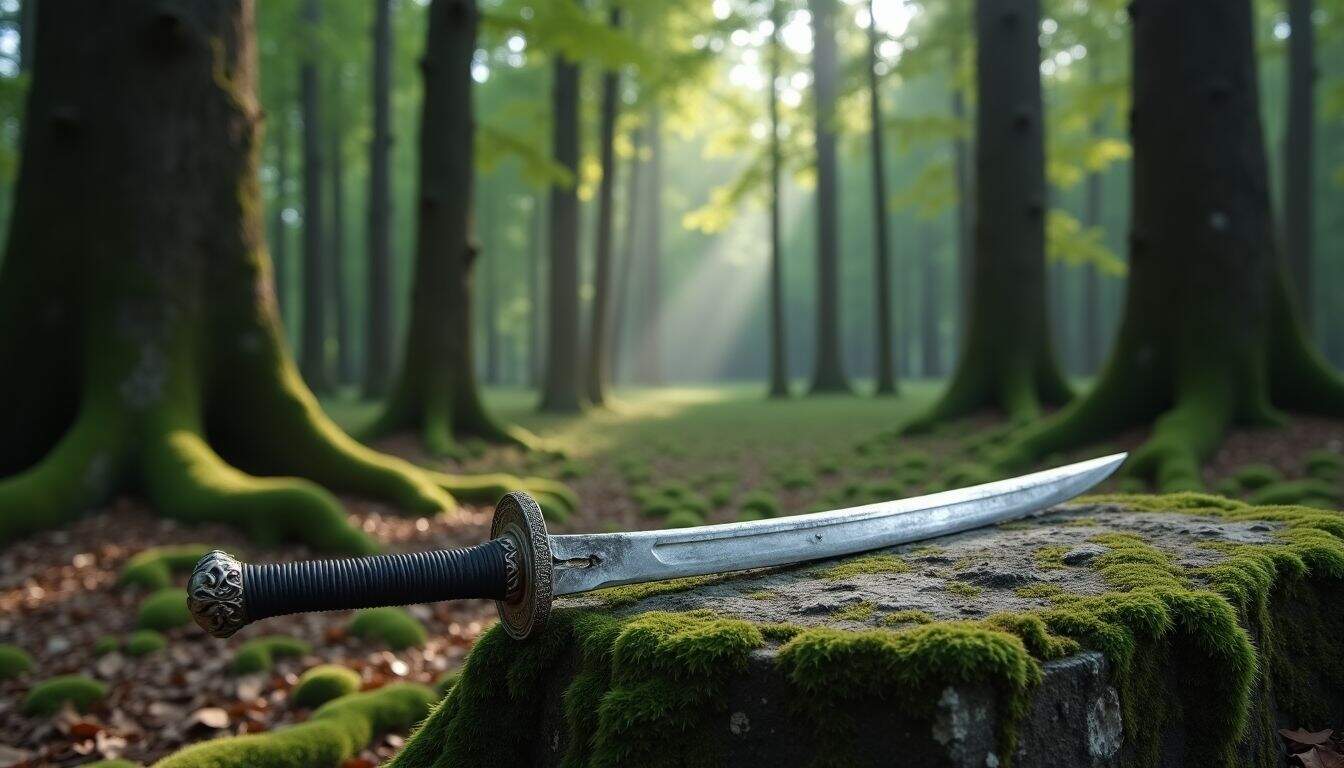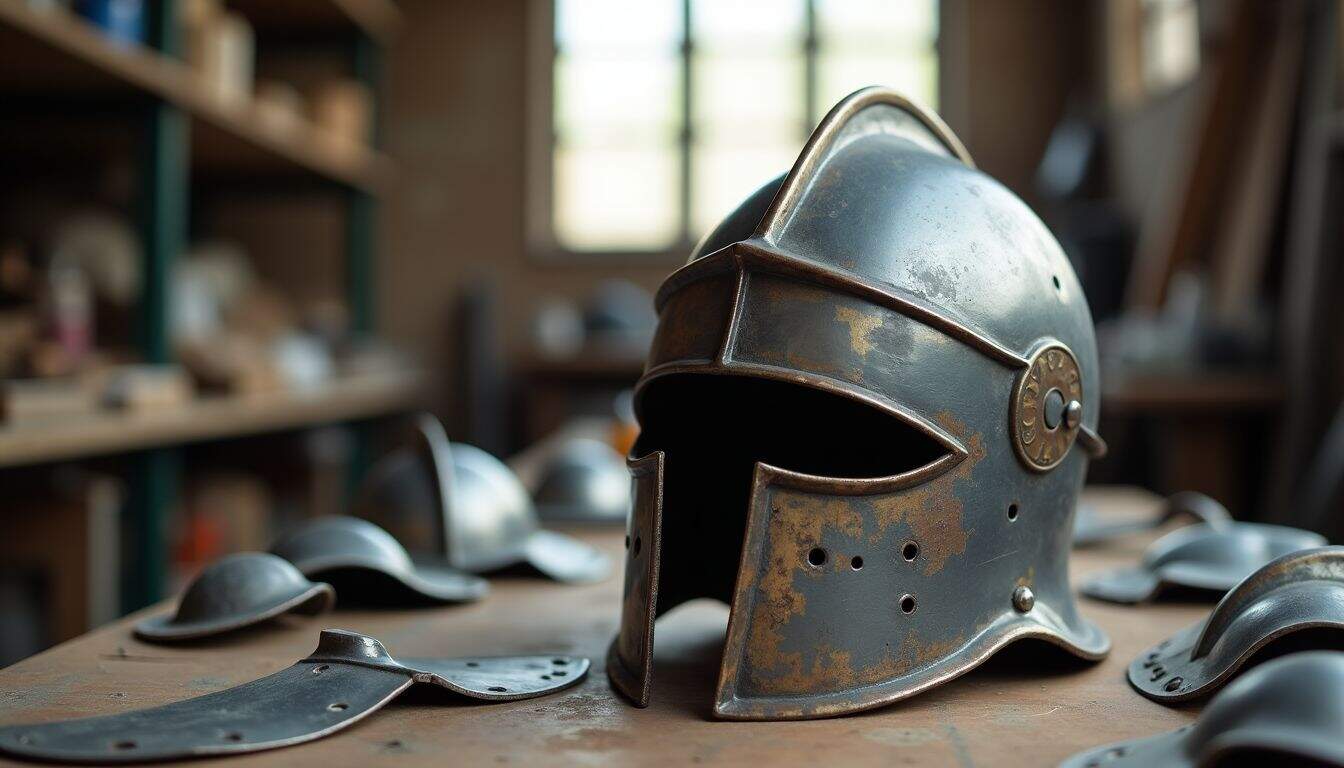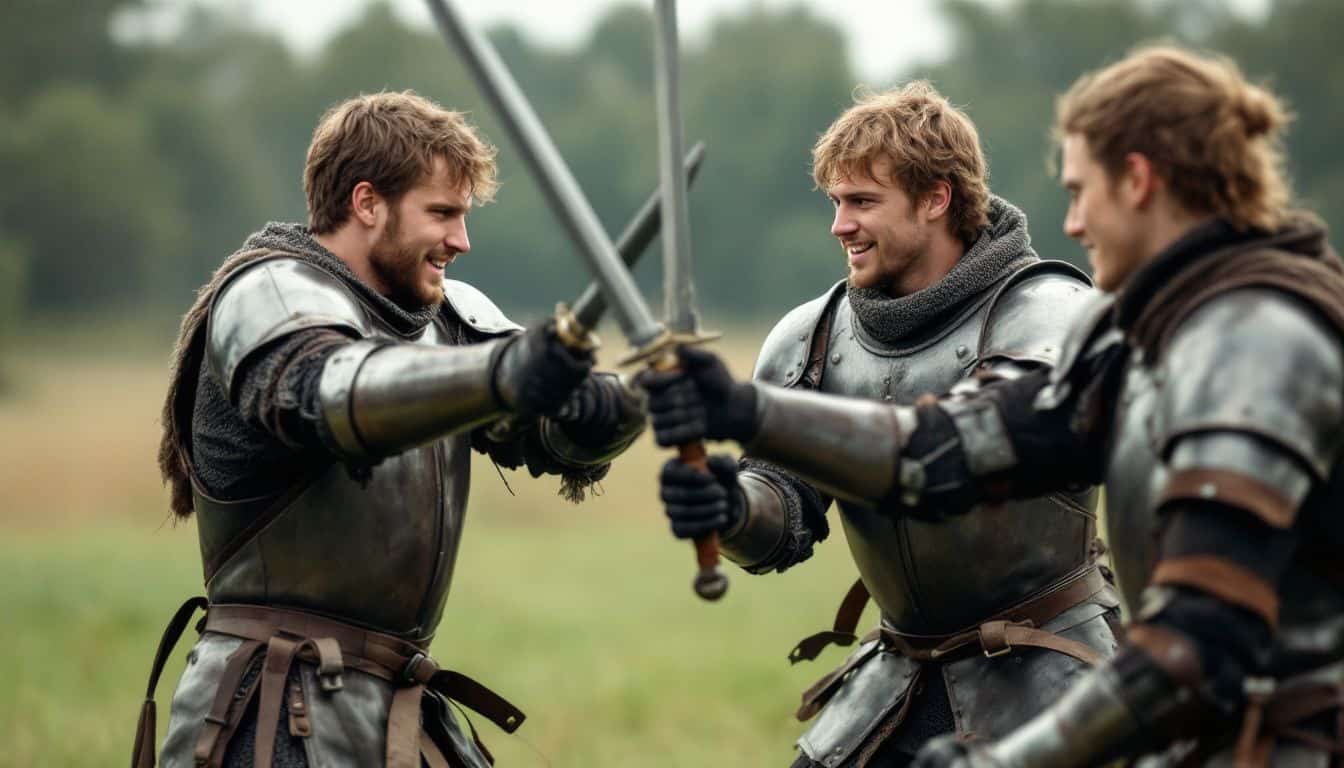Have you ever watched medieval tournaments online, seen women in full armor swinging long swords and poleaxes, and wondered how to get into buhurt yourself? Buhurt is a fast-growing martial art where teams battle fiercely yet safely with real armor and blunt steel weapons.
In these clear steps, you’ll learn exactly what gear you need, how to train correctly from basic fitness moves to smart grappling techniques—and even find the right team near you through Facebook groups or local events.
Ready to kick some serious armor-clad butt in 2025?
Key Takeaways
Buhurt is a full-contact medieval combat sport—players fight in actual armor using blunt steel weapons. Matches can be small, like 5-on-5, or huge, with up to 150 fighters on each team.
Basic steel armor runs about $800, while titanium armor costs extra but weighs around 40% less—making it a common choice for female fighters.
Training gear includes beginner sword bundles at $439 and practice halberds for $215, helping new players get comfortable before using official tournament-level weapons.
Many Buhurt clubs offer loaner armor for beginners, and some even provide free trial sessions, letting newcomers try it out without upfront costs.
To join the Buhurt International World Championship, fighters must sign up by March 31, 2024. Entry fees usually range from $50 up to $200, depending on the specific tournament.
Table of Contents
What is Buhurt?

Buhurt is a thrilling, contact team sport where fighters battle fiercely—in genuine, full-body armor—with blunt steel weapons. Matches vary widely in scale, from tight 5-on-5 skirmishes to huge battles of 150 combatants per side.
Teams arm themselves with swords, axes, and polearms to deliver powerful strikes. The sport has deep medieval roots, building from an era when protective armor reached peak reliability.
Modern-day Buhurt fighters use advanced materials and heavier, more durable weapons than those of historic times. Despite the intensity—and the metallic clang of steel blades and shafts colliding—Buhurt actually ranks safer than most full-contact sports, due largely to carefully designed gear like Buhurt helmets.
Fighters must be at least 18 years old before entering official tournaments.
The first time I took a chop from a halberd on my armor, I knew this wasn’t just martial arts—this was something deeper, connecting me to history while testing my limits.
Athletes blend moves from boxing, muay-thai, and historical fighting techniques to outmaneuver rivals. Knees, elbows, and shoulders become potent striking tools—right alongside spears and halberds.
Players gain advantages through sheer strength, quick thinking, and clever tactics. Women now represent an expanding portion of Buhurt competitors, often contributing fresh fighting styles and unique strategies.
This surprising combination of raw energy, precise moves, and tactical planning brings medieval warfare vividly into today’s sporting arena.
Essential Steps to Get into Buhurt

Getting into buhurt requires a few key steps before you can swing your first sword. You need to learn the basics, find your local group, and watch some fights to grasp what you’re getting into.
Understand the rules and format of the sport
 Buhurt rules provide a clear structure, keeping combat safe but exciting. Fighters must remain standing—once you’re down, you’re out for the round. The sport lets participants strike almost anywhere on the body using fists, elbows, knees, and legs.
Buhurt rules provide a clear structure, keeping combat safe but exciting. Fighters must remain standing—once you’re down, you’re out for the round. The sport lets participants strike almost anywhere on the body using fists, elbows, knees, and legs.
Grappling techniques and martial arts moves are fine too, adding strategy to matches. But there’s one key rule—safety always matters! Hits to the groin, neck, feet, and behind the knees stay strictly off-limits.
Also, stabbing isn’t allowed at any point. These restrictions protect players while still offering thrilling, intense action.
Combat happens within fenced spaces on solid, flat surfaces, ensuring stable footing for everyone involved. Your team claims victory by knocking down every opponent or simply having more fighters standing at the end of the timer.
Before your initial match, give the official rulebook a good read, and check out match videos online. Many women say knowing the basics helps boost their confidence before putting armor on.
Buhurt might seem rough at first glance—but clear guidelines turn this into an organized, skillful sport rather than chaotic fighting.
Research local and national buhurt communities

Now you’ve got the basics of buhurt down, your next move is finding a battle family. Local and national groups form a strong foundation for this exciting, growing sport. Knight Finder and Palmetto Knights Community are perfect starting places for women wanting to link up with local teams.
Both list various clubs by location, making it convenient for women to find teams within an easy drive.
Facebook groups offer another great way for women fighters to connect, ask for tips, and meet others sharing their interests. A lot of female fighters say social media introduced them to their first team.
Before signing up, try attending a tournament as a spectator—watching gives new fighters an inside look at team chemistry and combat styles. Plus, the entire buhurt community greets women warriors with excitement, openness, and encouragement.
Finding your buhurt team is like finding a second family. These are the people who will push you, protect you, and celebrate your growth as a fighter. – Elena Kovacs, Captain of Steel Roses Buhurt Team
Attend events or tournaments to observe and learn

Going to buhurt events puts you close to real combat moves in action. The upcoming tournament on March 8, 2025 is a great opportunity to see different fighting styles firsthand. Last year, I attended my first event and learned so many useful things, just by watching closely.
You can pick up new weapon methods and notice how fighters move around the arena. Lots of women compare buhurt to playing softball, as both demand team planning and personal skill.
Between matches, chat with the fighters—most gladly give advice to beginners. Sharing information within this community makes learning quicker and far more enjoyable. At these gatherings, you’ll find other women who share your passion and maybe even gain new training buddies.
Coaches frequently attend, too; you can connect with experienced trainers who’ll help you move forward. Observing professionals, how they manage their armor and perform their techniques, makes it clear what weapons and gear you’ll want for your own practice.
Acquiring the Right Equipment

Gear up with the right buhurt equipment – from basic armor sets to proper weapons and safety gear – to protect yourself while you bash shields and swing swords in this medieval combat sport…
Read on to learn exactly what you’ll need before stepping onto the battlefield.
Basic armor sets

Your first set of armor doesn’t have to empty your wallet—or slow you down. Most fighters choose steel for its good protection and affordable price. A typical starter set includes a helmet, chest plate, arm guards, and leg armor.
My initial steel armor cost about $800—far cheaper than I thought I’d pay for a full-contact fighting sport!
Steel armor does need regular upkeep, though, or else rust becomes an issue. Titanium armor offers a different benefit, cutting out about 40% of the weight you’d carry with steel. Many women competing in buhurt prefer titanium armor because of that lighter feel—but it does cost more right from the start.
Thickness counts more than metal type, anyway; armor that’s too thin won’t give enough protection from tough blows.
Your armor is your second skin in the arena. Choose it wisely, maintain it properly, and it will keep you safe battle after battle.
Official safety guidelines state armor must be the correct thickness and tempered right. Padding beneath the armor needs changing every two years; helmet liners should get switched out after one year or every 10 fights.
My own Buhurt Tech liner lasted just one intense season before a replacement became necessary. Good armor fits snugly yet allows free movement; too loose and it slips during fights, too tight—you’ll wear yourself out fast.
Most clubs let beginners borrow equipment at first, letting you try various styles and fits before parting with your cash.
Training weapons (e.g., longsword, halberd, axe)
Training weapons are essential tools for a solid buhurt start. You’ll begin by practicing with basic gear like swords, axes, and halberds, long before facing real combat. Many women in our club choose the starter sword bundles, priced around $439, to test different models and find a personal favorite.
Another popular choice among newcomers is the basic 120 cm halberd, costing about $215. Personally, I bought one of these halberds a year ago—I found the weight ideal for building arm strength and mastering correct form.
Soft training kits, such as the “Ares”, help beginners practice weapon skills without needing heavy steel armor. These kits ease early training, reducing fear while letting you swing, block, and move with total freedom.
The weapons have a realistic feel, similar enough to tournament equipment, yet safe enough to avoid major injuries. My club trains with these soft weapons twice a week before advancing to steel tools and harder drills.
Essential protective gear (e.g., neck protector, gauntlets, helmet)
Safety matters most in buhurt—so reliable gear makes a real difference. Protecting your neck from heavy impacts is critical. That’s why the Neck Protection Duty, priced around $95, remains highly popular with 88 units sold.
Durable steel mittens shield your hands effectively against direct strikes, averaging about $566 based on recent purchases. Helmets offer the strongest safety measure, making them the most vital armor piece of all.
Never overlook groin protection either; steel codpieces cost roughly $91, with sales reaching 253 units—clearly valued gear by experienced fighters.
Many women ask me about the best boots during practice sessions. After testing multiple brands, I learned reliable footwear helps prevent ankle injuries, giving you stability and confidence during combat.
The Advanced Buhurt boots with sabatons currently cost $419, down slightly from $439. So far, fighters have picked up 219 pairs. Next up, we’ll talk about finding and choosing a suitable buhurt team to start using all your gear effectively.
Training for Buhurt

Training for Buhurt demands both mental toughness and physical strength to excel in this medieval combat sport. You need to build stamina through cardio workouts and strength training while also mastering weapon techniques with practice partners.
Physical fitness and conditioning
Building your body for buhurt battles takes both strength and endurance. At first, I focused on basic lifts like squats, deadlifts, and bench presses to boost my core strength. These exercises help you move with ease in heavy armor.
Cardio training matters just as much—I alternate between sprints and steady-paced long runs, preparing for the start-stop rhythm of combat. Mixing in boxing or MMA workouts sharpens your strikes and defensive moves.
Many women excel at buhurt by relying on skill and leverage, not sheer physical strength alone.
The strongest weapon in buhurt isn’t your sword—it’s your conditioning.
Staying flexible protects you from injury and improves your reach in fights—I stretch shoulders, hips, and my back for about 15 minutes every day. Endurance counts big-time, especially fighting in armor weighing over 50 pounds.
Circuit workouts with a weighted vest can closely mimic those tough battle conditions. Grappling practice also plays a major role, since tackling opponents to the ground often seals the match.
The intense contact in buhurt means every muscle matters; you can’t afford to skip any. Alternate between heavy lifting sessions, mobility challenges, and practical fight moves for maximum impact.
Basic combat techniques
Proper stance is the key to solid buhurt fighting skills. Plant your feet shoulder-width apart, with knees slightly bent, to stay steady during a bout. Fluid, nimble footwork helps you dodge strikes without losing your balance.
Plenty of women succeed in buhurt by emphasizing clean technique over brute force. Effective strikes come from using your whole body, not arms alone. You’ll rotate your hips and shoulders, putting real power behind your blows.
Your training begins with soft weapons so you can safely grasp fundamentals. Initially, you’ll practice hitting and slashing against wooden posts (called pells) to sharpen muscle memory.
Working with a shield teaches you offense and defense at the same time. Your trainer will demonstrate how you can block enemy strikes while quickly striking back. You’ll develop battlefield awareness, too—learning to quickly scan your surroundings, and make instant decisions on your feet.
In group battles, this tactical skill often matters more for victory than individual strength or size.
Advanced sparring and group tactics
After getting comfortable with basic fighting skills, you’re ready for team training. Advanced sparring sharpens your solo abilities, bringing them into realistic battle drills alongside your partners.
Practicing with teammates boosted my precision in combat and helped me quickly adjust against tough opponents. With regular sparring, you’ll soon develop the ability to decide swiftly under pressure—a key asset for any woman competing in buhurt.
Group-focused tactics elevate your skill further through targeted battlefield exercises. Your squad will tackle special training drills that build team spirit and seamless coordination.
These activities will show you how to move together as a single unit, unlike individual battle moves. Every week, my team runs through flanking patterns and shield-wall formations, enhancing our strength for tournament matches.
The connection you build within your group becomes a powerful hidden advantage during combat.
Joining a Buhurt Team

Finding a Buhurt team means you’ll need to connect with local fighters who share your passion for medieval combat sports. You can start by visiting practice sessions of nearby clubs to see their training methods and team culture before you commit.
Finding local teams or clubs
Local Buhurt teams thrive in many large American cities. Knight Finder and the Palmetto Knights Community websites make it simple to locate nearby groups. These easy-to-use online tools let you find fighters near you in just a few clicks.
Every year, lots of women get involved in Buhurt using these helpful resources. Social media is another great way to connect with local clubs. One Facebook group, Armored Combat Sports, regularly introduces beginners to seasoned teams.
Most clubs happily welcome women warriors, appreciating the fresh styles they bring to the sport.
Your first step should involve checking out a practice session. For newcomers, most Buhurt teams offer trial sessions at no charge. Visiting in person lets you experience team energy without any pressure or cost.
You can notice how teammates interact, and decide if their coaching methods fit your fighting goals. Events like regional tournaments also offer a chance to see different teams compete.
Watching them fight provides valuable insights—and chatting with women fighters there can give you practical tips and advice. Each new fighter makes the Buhurt community stronger, bringing energy and passion to every battle.
Participating in tryouts or training sessions
Most buhurt clubs offer a free first practice session, especially for women interested in giving the sport a go. I joined my neighborhood club last year—honestly, it felt way less intimidating than I imagined.
Just throw on some comfy clothes, grab a water bottle, and you’re good to go. The club usually provides basic armor for newcomers at their first session. Many teams rely on Knight Finder, an online tool that helps newbies track down nearby clubs.
Coaches spend the first sessions teaching simple stances, basic movements, and easy weapon skills. Don’t stress about getting everything right—the teams happily welcome beginners at all fitness levels.
If the closest club isn’t nearby, traveling once a month can still work out pretty well. Several women on my team actually drive up to two hours each way just to make it to practice.
Between those face-to-face meetups, you can still practice footwork and fundamental strikes at home using online training videos. These online tools really keep your skills fresh—even if you’re not able to attend every practice session.
The buhurt community continues to grow as more women participate; clubs actively encourage women fighters to join in and give practice a try.
Building team chemistry and communication
Buhurt teams rely on tight bonds between fighters. Joining a local team gives you a great chance to build those relationships through joint combat training. Together, you’ll sharpen your defense techniques and practice attack moves, helping you gain trust in one another.
This bond becomes essential in tournaments, where split-second choices make or break matches. Practicing often lets your team develop special signals and speedy commands that withstand the noise and rush of battle.
In buhurt, effective teamwork isn’t always verbal. Through regular practice, your team builds its own quiet language—like a quick nod meaning “cover my left”, or a slight hand movement signaling “switch positions”.
These small signals happen naturally, as you meet weekly to improve your skills. Many women discover close friendships through buhurt, extending well beyond the fighting arena. These friendships form a lasting, supportive community of fellow warriors who truly understand the sport’s unique demands.
Preparing for Tournaments

Gearing up for tournaments means mastering the rules, signing up early, and making sure your gear passes all safety checks – read on to learn how to crush your first buhurt competition in 2025!
Understanding tournament formats and rules
Buhurt tournaments have clear, strict rules that you need to understand before joining the action. Most events follow a bracket format—teams face each other in rounds, one by one, until a champion stands victorious.
At my very first event, not knowing this setup left me feeling totally unprepared… and scrambling to keep up!
In each match, your main objective is simple: knock down your opponents or push them outside the battle area. Hits made within certain strike zones count, while aiming blows at knees or the groin is strictly off-limits.
Marshals will shout clear commands like “Break!” and “Fight!”—always listen carefully to their instructions. These guidelines keep everyone safe and ensure fair play.
Be sure you meet the required age limit and have all your medical paperwork ready before signing up. These important safety checks help protect every fighter on the field.
Registering for events
Once you understand the tournament guidelines, you’re ready to register for your first buhurt event. Most competitions open registration months in advance, giving you time to prepare comfortably.
My first time, I registered three months ahead, giving me enough time to gather gear and train effectively. Typically, signing up involves visiting the event’s official website and filling out your personal info along with your team’s details.
Entry fees usually range between $50 and $200, based on how large or well-known the event is.
Major tournaments have strict application deadlines, so timing matters here. For instance, if you’re applying to the Buhurt International World Championship, your application must be submitted no later than March 31, 2024.
After submission, the review period lasts up to half a year, followed by two weeks of voting. Be sure to carefully review gear requirements before signing up—most tournaments inspect equipment before allowing competitors to participate.
Keep an eye on team pages or social media groups for special early bird deals—these discounts can trim down your entry fees.
Finalizing equipment checks and certifications
Signing up for an event is just the start—you’ll need to double-check all your gear, too. Right before tournaments, inspectors perform detailed equipment checks that decide whether you’ll compete or watch from the sidelines.
They evaluate each piece carefully—from your $399 Metal Handforged Grand Armet Helmet down to your $289 Nuremberg Plate Gauntlets. My first inspection didn’t go well; my shoulder armor failed due to insufficient thickness.
So, I switched to the Handforged Gothic Spauldron Shoulder Armor, priced at $349.
Safety ranks highest in buhurt, especially for women who often face opponents with more size and strength. That’s why bringing extra gear is smart in case any pieces fail inspection.
Your helmet, gauntlets, and neck protector require careful inspection, as they shield your most critical parts. Most tournaments now ask for proof of armor thickness, typically provided through clear photos or certificates from trusted armor makers.
Prices can range widely—from about $199 up to $2,999 for a full set—but investing in quality matters. Good gear keeps you safe against real steel weapons and powerful strikes.
Progressing in Buhurt

Buhurt fighters grow better with each battle they face in the arena. You can level up your skills through special workshops and by making friends with top fighters across the country.
Gaining experience through matches
Real matches offer lessons practice alone can’t teach you. Every fight sharpens your timing, refines your distance judgment, and helps you read an opponent’s moves. Many women notice their fighting style changing after just five or six tournament bouts.
With each contest, your body reacts quicker, and your mind spots openings you overlooked before. International tournaments give you valuable chances to test yourself against varied fighting styles.
You’ll face different weapons and strategies, forcing you to think on your feet.
Stepping into the ring boosts your confidence as you feel real hits and realize—you can handle them. Surviving those first strikes proves you’re stronger than you imagined. That surge of adrenaline pushes you beyond limits you didn’t even realize were there.
Your team will notice how quickly you’ve improved, as you begin contributing more to group plans. Keep track of your growth in a journal—record what worked, what didn’t, and how each bout made you feel.
These notes can direct your future training. Conditioning matters even more in actual fights, since often, stamina determines who stays standing to the end.
Improving skills with advanced training
Taking your buhurt skills to the next level takes more than basic training alone. Female fighters must consistently step beyond their comfort zones and blend different training methods to improve.
Lifting weights builds brute strength, while CrossFit routines boost endurance needed for extended battles. Regular, full-contact martial arts training also sharpens reflexes and fighting instincts.
To grow faster, it’s helpful to train alongside local teams who share your enthusiasm. They can quickly notice areas you might miss alone, making it easier to improve your weak spots.
Soft training equipment helps you practice safely, letting you master movements without risk before handling actual weapons. Spend time working on grappling, since close combat skills are critical in real tournaments.
The most successful female competitors often combine various workout routines to build well-rounded abilities. Allow yourself rest days in between tough sessions, giving your muscles proper time to recover.
Top fighters consistently practice in diverse ways, pushing beyond limits to steadily improve.
Networking with the buhurt community
Beyond training skills, forming connections within the buhurt community leads to personal growth and meaningful friendships. With genuine openness and a shared passion, the buhurt crowd warmly welcomes new fighters.
At my own first tournament, seasoned participants generously offered me pointers on stance and grip—without a hint of judgment.
Friendships often spring up naturally during tournaments and social events. Plenty of teams host regular practice sessions, offering new fighters the chance to train together and get acquainted.
These informal meetups encourage friendships that last even after the battles finish. Plus, having a supportive crew around you makes it easier to find quality gear, pick up fresh techniques, and stay informed about future events.
For women especially, shared experiences and challenges create powerful connections, building a close circle within this broader fighting community.
How Will Buhurt Evolve in 2025?

Buhurt is set for big shifts in 2025, with the return of the Buhurt International World Championships after skipping 2024 altogether. This exciting event offers the sport a fresh start, and organizers are already busy reviewing proposals from countries eager to host.
Host nations must submit clear plans outlining event venues, dates, transportation options, and medical services. Judges will evaluate proposals based on three key factors: technical skills at 50%, adherence to competition rules at 20%, and safety measures making up the final 30%.
These demanding guidelines will push athletes to step up their training and sharpen their combat skills. Several female fighters mentioned to me they’re thrilled about these new standards, as they promise fairer matches and equal opportunities for everyone competing.
Improved safety guidelines will help make the sport even more popular. Last year, I caught some exciting matches featuring women fighters who skillfully handled swords and axes—impressive to watch.
Under new regulations, armor inspections will become stricter, and medical teams must stand by ready at every event. Team strategies are shifting toward coordinated group maneuvers instead of traditional one-on-one combat.
This tactical change means smaller-sized fighters can rely on smart teamwork rather than pure strength. Many within the combat sports community expect women fighter participation to increase as these rules take effect.
Local clubs are already seeing more women signing up for beginner training sessions using practice weapons. With so much fresh interest, the 2025 championships will likely highlight this growing diversity in a sport historically filled mostly by men.
People Also ask
What is Buhurt and why is it becoming so popular?
Buhurt is a medieval combat sport where participants fight in actual armor with real—but blunted—weapons. It’s catching on fast, mixing history, fitness, and pure adrenaline in one thrilling experience.
What kind of gear should I get to start training in Buhurt?
You’ll need basic armor: a helmet, protective gloves, and sturdy body armor. Most clubs allow beginners to borrow equipment initially, so you can check it out before spending money on your own set.
Is Buhurt physically demanding for beginners?
Buhurt is very physical—you’ll fight while wearing 50 to 70 pounds of armor. It’s best to start with basic fitness activities to build up strength and stamina. The bright side is, your fitness level usually rises quickly once you begin training regularly.
Can women compete in Buhurt?
Definitely! Women participate in matches all around the globe, either in dedicated women’s leagues or mixed-gender teams. Buhurt is open to everyone, no matter their gender; the important thing is to show up ready to train and jump into battle.
Referenced
- https://www.buhurttech.com/how-to-start
- https://www.buhurt.org.au/rules-of-buhurt
- https://botn.info/rules/rules-for-buhurt-categories/
- https://medievalextreme.com/the-beginners-guide-how-to-find-your-first-buhurt-team/
- https://www.facebook.com/groups/Armoredcombatsports/posts/1752238405599346/
- https://www.buhurttech.com/faq
- https://www.iguides.org/mastering-buhurt-halberd/ (2025-01-27)
- https://medievalextreme.com/neck-protection/
- https://www.buhurttech.com/training
- https://sparta.training/blog/full-contact-armored-combat-training-tips-for-buhurt-and-hmb-soft/
- https://www.buhurtinternational.com/post/buhurt-international-world-championship-2025
